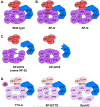Hot topics in DNA repair: the molecular basis for different disease states caused by mutations in TFIIH and XPG
- PMID: 18077223
- PMCID: PMC2246058
- DOI: 10.1016/j.dnarep.2007.10.007
Hot topics in DNA repair: the molecular basis for different disease states caused by mutations in TFIIH and XPG
Abstract
Alterations in genes involved in nucleotide excision repair (NER) are associated with three genetic disorders, xeroderma pigmentosum (XP), Cockayne syndrome (CS) and trichothiodystrophy (TTD). The transcription and repair factor TFIIH is a central component of NER and mutations of its subunits are associated with all three diseases. A recent report provides a molecular basis for how mutations in the NER endonuclease XPG that affect the interaction of TFIIH might give rise to CS features. In cells of XP-G patients with a combined XP and CS phenotype, XPG fails to associate with TFIIH and as a consequence the CAK subunit dissociates from core TFIIH. A simplified, but general model of how various assembly and disassembly states of TFIIH can be invoked to explain different disease states is discussed. Accordingly, defects in specific enzymatic functions typically result in XP, dissociation of the CAK subunit from TFIIH is associated with XP/CS and a more generalized destabilization of TFIIH gives rise to TTD. While this classification provides a useful framework to understand how alterations in TFIIH correlate with disease states, it does not universally apply and relevant exception and alternative explanations are discussed.
Figures

Similar articles
-
XPG stabilizes TFIIH, allowing transactivation of nuclear receptors: implications for Cockayne syndrome in XP-G/CS patients.Mol Cell. 2007 Apr 27;26(2):231-43. doi: 10.1016/j.molcel.2007.03.013. Mol Cell. 2007. PMID: 17466625
-
Lack of CAK complex accumulation at DNA damage sites in XP-B and XP-B/CS fibroblasts reveals differential regulation of CAK anchoring to core TFIIH by XPB and XPD helicases during nucleotide excision repair.DNA Repair (Amst). 2012 Dec 1;11(12):942-50. doi: 10.1016/j.dnarep.2012.09.003. Epub 2012 Oct 17. DNA Repair (Amst). 2012. PMID: 23083890 Free PMC article.
-
Persistence of repair proteins at unrepaired DNA damage distinguishes diseases with ERCC2 (XPD) mutations: cancer-prone xeroderma pigmentosum vs. non-cancer-prone trichothiodystrophy.Hum Mutat. 2008 Oct;29(10):1194-208. doi: 10.1002/humu.20768. Hum Mutat. 2008. PMID: 18470933 Free PMC article.
-
New insights into the combined Cockayne/xeroderma pigmentosum complex: human XPG protein can function in transcription factor stability.Mol Cell. 2007 Apr 27;26(2):162-4. doi: 10.1016/j.molcel.2007.04.002. Mol Cell. 2007. PMID: 17466619 Review.
-
A history of TFIIH: two decades of molecular biology on a pivotal transcription/repair factor.DNA Repair (Amst). 2011 Jul 15;10(7):714-21. doi: 10.1016/j.dnarep.2011.04.021. Epub 2011 May 17. DNA Repair (Amst). 2011. PMID: 21592869 Review.
Cited by
-
Association between the ERCC5 Asp1104His polymorphism and cancer risk: a meta-analysis.PLoS One. 2012;7(7):e36293. doi: 10.1371/journal.pone.0036293. Epub 2012 Jul 18. PLoS One. 2012. PMID: 22815677 Free PMC article.
-
Structural and functional evidence that Rad4 competes with Rad2 for binding to the Tfb1 subunit of TFIIH in NER.Nucleic Acids Res. 2013 Feb 1;41(4):2736-45. doi: 10.1093/nar/gks1321. Epub 2013 Jan 7. Nucleic Acids Res. 2013. PMID: 23295669 Free PMC article.
-
Structural and functional characterization of interactions involving the Tfb1 subunit of TFIIH and the NER factor Rad2.Nucleic Acids Res. 2012 Jul;40(12):5739-50. doi: 10.1093/nar/gks194. Epub 2012 Feb 28. Nucleic Acids Res. 2012. PMID: 22373916 Free PMC article.
-
Structure and mechanism of the UvrA-UvrB DNA damage sensor.Nat Struct Mol Biol. 2012 Feb 5;19(3):291-8. doi: 10.1038/nsmb.2240. Nat Struct Mol Biol. 2012. PMID: 22307053
-
Cell-autonomous progeroid changes in conditional mouse models for repair endonuclease XPG deficiency.PLoS Genet. 2014 Oct 9;10(10):e1004686. doi: 10.1371/journal.pgen.1004686. eCollection 2014 Oct. PLoS Genet. 2014. PMID: 25299392 Free PMC article.
References
-
- Friedberg EC, Walker GC, Siede W, Wood RD, Schultz RA, Ellenberger T. DNA Repair and Mutagenesis. ASM Press; Washington DC: 2005.
-
- Gillet LC, Schärer OD. Molecular mechanisms of Mammalian global genome nucleotide excision repair. Chem. Rev. 2006;106:253–276. - PubMed
-
- Svejstrup JQ. Mechanisms of transcription-coupled DNA repair. Nat. Rev. Mol. Cell. Biol. 2002;3:21–29. - PubMed
-
- Lehmann AR. DNA repair-deficient diseases, xeroderma pigmentosum, Cockayne syndrome and trichothiodystrophy. Biochimie. 2003;85:1101–1111. - PubMed
Publication types
MeSH terms
Substances
Grants and funding
LinkOut - more resources
Full Text Sources
Research Materials

